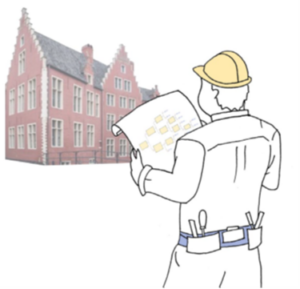Facade degradation risks in relation to energy renovation: towards a clear decision framework
FWO (Research Foundation Flanders) research scholarship grant number 1S71922N
PhD Researcher: Kaat Janssens (Ghent University)
Supervisors: Nathan Van Den Bossche (Ghent University), Dr Valentina Marincioni (UCL)
Background
Over the last two decades significant research efforts have been done to study the hygrothermal behaviour of building components. Today, several simulation models (e.g. Wufi, Delphin) are commercially available at low prices, and there is an international standard EN 15026 that provides a number of guidelines concerning the simulation approach. These numerical simulation models allow to predict the hygrothermal response of building components subjected to climatic boundary conditions, and use the output to help assess the risk for premature deterioration due to freeze-thaw damage, mould growth, corrosion, wood decay, algae growth and salt damage (Straube and Schumacher 2006, Guizzardi et al. 2015, Zhou et al. 2020). Both for new constructions as well as existing buildings it provides a valuable tool to go beyond very conservative rules of thumb, and enables specific solutions tailored to the case at hand. However, the adoption and application of these tools in practice remains limited. One of the main reasons is the sensitivity of the output to specific input variables, that requires a thorough understanding of material moisture storage functions and transfer processes (Calle, 2020). Furthermore, there are a number of challenges in the field of hygrothermal simulations:
hygrothermal behaviour of building components. Today, several simulation models (e.g. Wufi, Delphin) are commercially available at low prices, and there is an international standard EN 15026 that provides a number of guidelines concerning the simulation approach. These numerical simulation models allow to predict the hygrothermal response of building components subjected to climatic boundary conditions, and use the output to help assess the risk for premature deterioration due to freeze-thaw damage, mould growth, corrosion, wood decay, algae growth and salt damage (Straube and Schumacher 2006, Guizzardi et al. 2015, Zhou et al. 2020). Both for new constructions as well as existing buildings it provides a valuable tool to go beyond very conservative rules of thumb, and enables specific solutions tailored to the case at hand. However, the adoption and application of these tools in practice remains limited. One of the main reasons is the sensitivity of the output to specific input variables, that requires a thorough understanding of material moisture storage functions and transfer processes (Calle, 2020). Furthermore, there are a number of challenges in the field of hygrothermal simulations:
- Material properties are very difficult to measure, and liquid transport functions rely on indirect measurements and fitting algorithms, which entails inherent uncertainties
- Variability in material properties can have a significant impact on degradation risks due to non-linear effects and performance criteria with threshold values
- The impact of deficiencies such as air leakage and rain water infiltration is difficult to quantify, as these require experimental research and the assessment of the likelihood
- Most degradation models and criteria are not implemented in the commercial software packages, which typically requires additional post-processing in a programming environment (R, Matlab, Python)
About the research aims
These challenges again hamper the straightforward use of simulation models in practice, and will not be tackled in the next decade. Hence, this research proposal aims to develop a methodology to convey the results and insights from extensive hygrothermal simulations to the building industry. The use of hygrothermal models can be structured as follows:
- Guideline to run simulations by building practitioners
- Building practitioners can access the results of general simulations directly in a database
- Building practitioners can provide a variable degree of detail on the input variables and receive a comprehensive overview of the results
- Decision trees steward building practitioners to assess the performance of specific configurations
- Rules of thumb and technical guidelines are derived from simulations
Taking part in research
You are invited to take part in this project, as a retrofit practitioner or as an occupant, to test the tools provided and developed in this research. Please contact Kaat Janssens if you wish to participate.
Contact for further information
Please contact Kaat Janssens at Kaat.Janssens@ugent.be if you have any queries about this research. You can also contact ukcmb@ucl.ac.uk.
